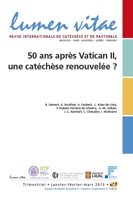 previous article in this issue previous article in this issue | next article in this issue  |

|
Document Details : Title: La catéchèse renouvelée par l'adolescent Subtitle: Compte rendu d'un séminaire de recherche de l'ISPC Author(s): MOLINARIO, Joël , DE THUY-CROIZÉ, Véronique Journal: Lumen Vitae Volume: 68 Issue: 4 Date: 2013 Pages: 455-466 DOI: 10.2143/LV.68.4.7000008 Abstract : Comment le rencontre des adolescents et la relation avec eux est-elle susceptible de changer notre manière de proposer la foi et même de l'exprimer? Le matériau était l'analyse de cinq documents catéchétiques destinés aux adolescents (français, congolais et vietnamiens): leur approche de la foi, le lexique utilisé et les figures de croyants qu'ils valorisent. Si l'on peut rapprocher analogiquement la crise actuelle de la foi et l'expérience adolescente par les remises en cause et les franchissements de seuils nécaissaires, on peut faire l'hypothèse que la foi éprouvée des adolescents a beaucoup à nous dire et que le défi d'une catéchèse des adolescents a une parenté certaine avec le défi de la nouvelle évangélisation: importance du rapport au corps, de la liturgie, des liens relationnels, de la mise en récit (Bible et figures de témoins), de l'intériorité, d'une bonne formation des catéchistes. When it comes to catechesis for adolescents, we often hear of the discouragement of parents and catechists and the indifference of young people towards faith. Taking these presuppositions as a starting point, a task force of the ISPC (Higher Institute for Pastoral Ministry and Catechesis, Paris) has begun to reflect on the matter by turning the question around: how can the encounter with teens and our relationship with them change our way of proposing and even of expressing our faith? The starting point for the reflection was the analysis of five catechetical documents intended for teens (French, Congolese and Vietnamese): their approach to the faith, the vocabulary used and the figures they chose as model people of faith. Drawing an analogy between the current crisis of faith and the experience of adolescents, we can advance the hypothesis that the faith of adolescents has a lot to teach us and that the challenge of designing a suitable catechesis for teens closely resembles the challenge of the New Evangelisation: the importance of one's relationship to the body, of the liturgy, of interpersonal relationships, of the use of narrative (Bible and witnesses), of interiority and of a sound formation of catechists. Moreover, the university context offered to this working group, which is an intercultural one, not only facilitated a creative approach, respecting the origins of each participant, but gave rise to a critical reflection on the catechesis of teens. One of the fruits of this process was the recognition of the transculturality of the faith. A reflection that is to be continued. |
